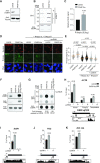PARP1 associates with R-loops to promote their resolution and genome stability
- PMID: 36794853
- PMCID: PMC10018367
- DOI: 10.1093/nar/gkad066
PARP1 associates with R-loops to promote their resolution and genome stability
Abstract
PARP1 is a DNA-dependent ADP-Ribose transferase with ADP-ribosylation activity that is triggered by DNA breaks and non-B DNA structures to mediate their resolution. PARP1 was also recently identified as a component of the R-loop-associated protein-protein interaction network, suggesting a potential role for PARP1 in resolving this structure. R-loops are three-stranded nucleic acid structures that consist of a RNA-DNA hybrid and a displaced non-template DNA strand. R-loops are involved in crucial physiological processes but can also be a source of genome instability if persistently unresolved. In this study, we demonstrate that PARP1 binds R-loops in vitro and associates with R-loop formation sites in cells which activates its ADP-ribosylation activity. Conversely, PARP1 inhibition or genetic depletion causes an accumulation of unresolved R-loops which promotes genomic instability. Our study reveals that PARP1 is a novel sensor for R-loops and highlights that PARP1 is a suppressor of R-loop-associated genomic instability.
© The Author(s) 2023. Published by Oxford University Press on behalf of Nucleic Acids Research.
Figures






References
-
- Lonskaya I., Potaman V.N., Shlyakhtenko L.S., Oussatcheva E.A., Lyubchenko Y.L., Soldatenkov V.A.. Regulation of poly(ADP-ribose) polymerase-1 by DNA structure-specific binding. J. Biol. Chem. 2005; 280:17076–17083. - PubMed
Publication types
MeSH terms
Substances
Grants and funding
LinkOut - more resources
Full Text Sources
Research Materials
Miscellaneous

